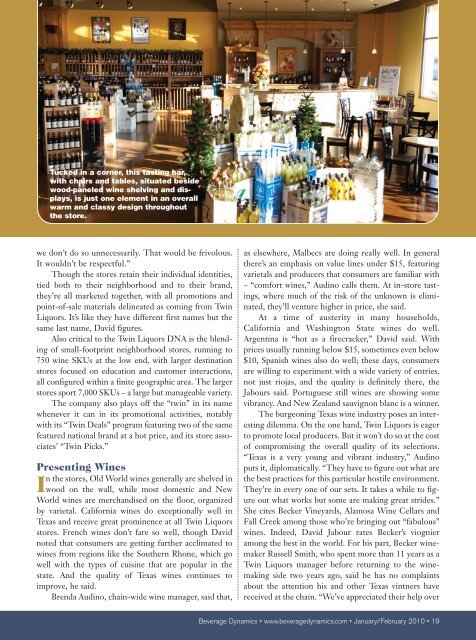In March, David Jabour stepped up to a - Twin Liquors
In March, David Jabour stepped up to a - Twin Liquors
In March, David Jabour stepped up to a - Twin Liquors
You also want an ePaper? Increase the reach of your titles
YUMPU automatically turns print PDFs into web optimized ePapers that Google loves.
we don’t do so unnecessarily. That would be frivolous.<br />
It wouldn’t be respectful.”<br />
Though the s<strong>to</strong>res retain their individual identities,<br />
tied both <strong>to</strong> their neighborhood and <strong>to</strong> their brand,<br />
they’re all marketed <strong>to</strong>gether, with all promotions and<br />
point-of-sale materials delineated as coming from <strong>Twin</strong><br />
<strong>Liquors</strong>. It’s like they have different first names but the<br />
same last name, <strong>David</strong> figures.<br />
Also critical <strong>to</strong> the <strong>Twin</strong> <strong>Liquors</strong> DNA is the blending<br />
of small-footprint neighborhood s<strong>to</strong>res, running <strong>to</strong><br />
750 wine SKUs at the low end, with larger destination<br />
s<strong>to</strong>res focused on education and cus<strong>to</strong>mer interactions,<br />
all configured within a finite geographic area. The larger<br />
s<strong>to</strong>res sport 7,000 SKUs – a large but manageable variety.<br />
The company also plays off the “twin” in its name<br />
whenever it can in its promotional activities, notably<br />
with its “<strong>Twin</strong> Deals” program featuring two of the same<br />
featured national brand at a hot price, and its s<strong>to</strong>re associates’<br />
“<strong>Twin</strong> Picks.”<br />
Presenting Wines<br />
I n<br />
Tucked in a corner, this tasting bar,<br />
with chairs and tables, situated beside<br />
wood-paneled wine shelving and displays,<br />
is just one element in an overall<br />
warm and classy design throughout<br />
the s<strong>to</strong>re.<br />
the s<strong>to</strong>res, Old World wines generally are shelved in<br />
wood on the wall, while most domestic and New<br />
World wines are merchandised on the floor, organized<br />
by varietal. California wines do exceptionally well in<br />
Texas and receive great prominence at all <strong>Twin</strong> <strong>Liquors</strong><br />
s<strong>to</strong>res. French wines don’t fare so well, though <strong>David</strong><br />
noted that consumers are getting further acclimated <strong>to</strong><br />
wines from regions like the Southern Rhone, which go<br />
well with the types of cuisine that are popular in the<br />
state. And the quality of Texas wines continues <strong>to</strong><br />
improve, he said.<br />
Brenda Audino, chain-wide wine manager, said that,<br />
as elsewhere, Malbecs are doing really well. <strong>In</strong> general<br />
there’s an emphasis on value lines under $15, featuring<br />
varietals and producers that consumers are familiar with<br />
– “comfort wines,” Audino calls them. At in-s<strong>to</strong>re tastings,<br />
where much of the risk of the unknown is eliminated,<br />
they’ll venture higher in price, she said.<br />
At a time of austerity in many households,<br />
California and Washing<strong>to</strong>n State wines do well.<br />
Argentina is “hot as a firecracker,” <strong>David</strong> said. With<br />
prices usually running below $15, sometimes even below<br />
$10, Spanish wines also do well; these days, consumers<br />
are willing <strong>to</strong> experiment with a wide variety of entries,<br />
not just riojas, and the quality is definitely there, the<br />
<strong>Jabour</strong>s said. Portuguese still wines are showing some<br />
vibrancy. And New Zealand sauvignon blanc is a winner.<br />
The burgeoning Texas wine industry poses an interesting<br />
dilemma. On the one hand, <strong>Twin</strong> <strong>Liquors</strong> is eager<br />
<strong>to</strong> promote local producers. But it won’t do so at the cost<br />
of compromising the overall quality of its selections.<br />
“Texas is a very young and vibrant industry,” Audino<br />
puts it, diplomatically. “They have <strong>to</strong> figure out what are<br />
the best practices for this particular hostile environment.<br />
They’re in every one of our sets. It takes a while <strong>to</strong> figure<br />
out what works but some are making great strides.”<br />
She cites Becker Vineyards, Alamosa Wine Cellars and<br />
Fall Creek among those who’re bringing out “fabulous”<br />
wines. <strong>In</strong>deed, <strong>David</strong> <strong>Jabour</strong> rates Becker’s viognier<br />
among the best in the world. For his part, Becker winemaker<br />
Russell Smith, who spent more than 11 years as a<br />
<strong>Twin</strong> <strong>Liquors</strong> manager before returning <strong>to</strong> the winemaking<br />
side two years ago, said he has no complaints<br />
about the attention his and other Texas vintners have<br />
received at the chain. “We’ve appreciated their help over<br />
Beverage Dynamics • www.beveragedynamics.com • January/February 2010 • 19


